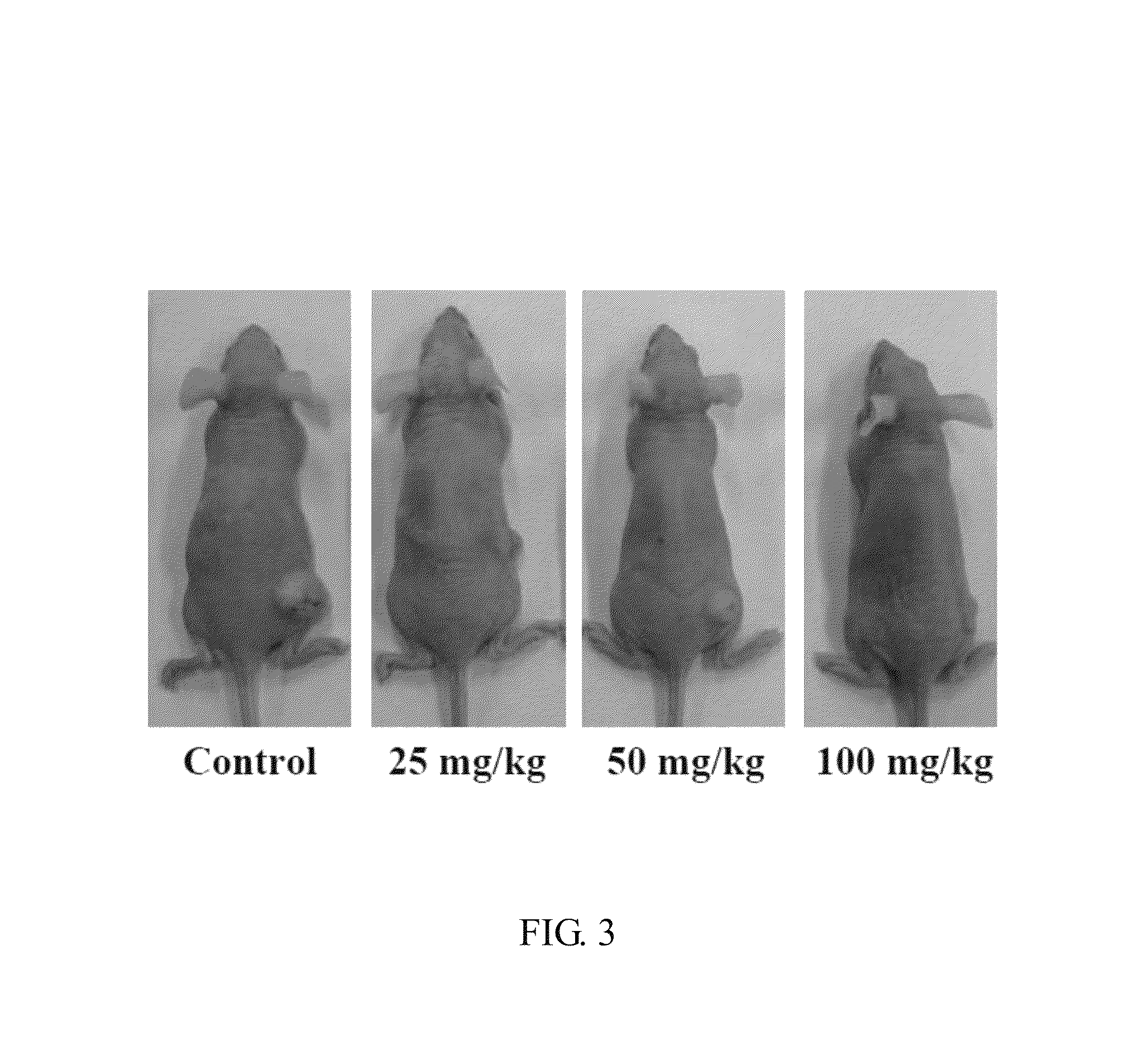Stilbenoid compound as inhibitor for squamous carcinoma and hepatoma and uses thereof
a technology of squamous carcinoma and inhibitors, which is applied in the direction of biocide, organic chemistry, drug compositions, etc., can solve the problems of poor prognosis of patients, low survival rate of most patients, and many side effects of chemotherapy, and achieves low toxicity, high water solubility, and potent anticancer activity
- Summary
- Abstract
- Description
- Claims
- Application Information
AI Technical Summary
Benefits of technology
Problems solved by technology
Method used
Image
Examples
example 1
Preparation of 4-(3,5-dimethoxystyryl)phenyl 2,2,5-trimethyl-1,3-dioxane-5-carboxylate (compound 2-3)
[0057]Please refer to Scheme 2. To a stirred solution of compound 2-2 (0.740 g, 4.25 mmol) in CH2Cl2 (25 mL), N,N-dicyclohexylcarbodiimide (DCC, 1.140 g, 5.53 mmol), compound 2-1 (1.090 g, 4.25 mmol) and N,N-dimethylaminopyridine, (DMAP, 0.052 g, 0.43 mmol) was added sequentially at room temperature. The reaction mixture was stirred at the same temperature for 18 hours and then H2O (15 mL) was added to quench the reaction. The aqueous layer was separated and extracted with CH2Cl2 (2×20 mL). The combined organic extracts were washed with brine, dried over MgSO4, filtered and concentrated to give the crude product, which was then purified by flash chromatography on silical gel with EtOAc / n-hexane (1:2) to afford compound 2-3 (1.070 g, 61% yield) as white solid.
[0058]1H NMR (CDCl3, 200 MHz): δ 7.49 (d, J=8.6 Hz, 2H), 7.09-6.99 (m, 4H), 6.65-6.63 (m, 2H), 6.38 (s, 1H), 4.21 (d, J=11.8 Hz...
example 2
Preparation of 4-(3,5-dimethoxystyryl)phenyl-3-hydroxy-2-(hydroxymethyl)-2-methylpropanoate (compound 2-4)
[0059]Please refer to Scheme 2. To a stirred solution of compound 2-3 (0.900 g, 2.18 mmol) in CH2Cl2 (20 mL), 12 N HCl / MeOH (1:30, 2 ml) was added at room temperature. The reaction mixture was stirred at the same temperature for 30 minutes and then concentrated to give the crude product, which was then recrystallized to give compound 2-4 (0.66 g, 81% yield) as white solid.
[0060]1H NMR (CDCl3, 200 MHz): δ 7.50 (d, J=8.6 Hz, 2H), 7.19-6.99 (m, 4H), 6.64-6.63 (m, 2H), 6.38 (s, 1H), 4.05 (d, J=10.0 Hz, 2H), 3.85-3.80 (m, 8H), 2.89 (br s, 2H), 1.21 (s, 3H); 13C NMR (CDCl3, 50 MHz): δ174.7, 160.9, 149.9, 139.1, 135.2, 129.0, 128.0, 127.5, 121.8, 104.5, 100.1, 68.7, 55.3, 49.5, 17.0. Melting point of compound 2-4:108.0-109.5° C.
[0061]For detailed synthesis of compound 3-3, 3-4, 3-5, and 3-6, please refer to Scheme 3.
[0062]
example 3
Preparation of 4′-(2,2,5-trimethyl-1,3-dioxane-5-carboxy)-resveratrol (compound 3-3) and 3,4′-(2,2,5-trimethyl1,3-dioxane-5-carboxy)-resveratrol (compound 3-4)
[0063]To a stirred solution of compound 3-2 (1.373 g, 7.88 mmol) in DMF (25 mL), 1-ethyl-3-(3-dimethylaminopropyl)carbodiimide (EDCI, 1.224 g, 7.88 mmol), Hydroxybenzotriazole (HOBt, 1.065 g, 7.88 mmol), compound 3-1 (0.600 g, 2.62 mmol) and Et3N (0.797 g, 7.88 mmol) were added sequentially at room temperature. The reaction mixture was stirred at the same temperature for 32 hours and then H2O (30 mL) was added. The combined organic extracts were washed with brine, dried over MgSO4, filtered and concentrated to give the crude product, which was then purified by flash chromatography on silical gel with EtOAc / CH2Cl2 / n-hexane (1:1:1) to afford compound 3-3 (0.537 g, 53% yield) as white solid and compound 3-4 (0.125, 9% yield) as white solid. Please note that compound 3-3 of this example is also the compound 1-3 of Scheme 1; compou...
PUM
| Property | Measurement | Unit |
|---|---|---|
| pharmaceutical composition | aaaaa | aaaaa |
| drug resistance | aaaaa | aaaaa |
| antioxidant | aaaaa | aaaaa |
Abstract
Description
Claims
Application Information
 Login to View More
Login to View More - R&D
- Intellectual Property
- Life Sciences
- Materials
- Tech Scout
- Unparalleled Data Quality
- Higher Quality Content
- 60% Fewer Hallucinations
Browse by: Latest US Patents, China's latest patents, Technical Efficacy Thesaurus, Application Domain, Technology Topic, Popular Technical Reports.
© 2025 PatSnap. All rights reserved.Legal|Privacy policy|Modern Slavery Act Transparency Statement|Sitemap|About US| Contact US: help@patsnap.com



